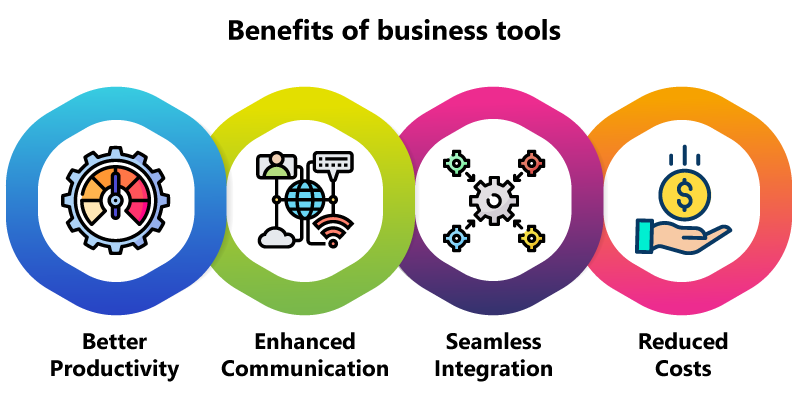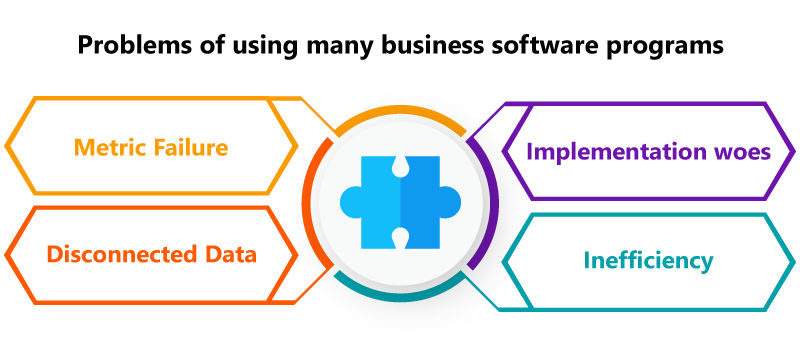
Too many cooks spoil the broth, which is among the biggest problems of using many business software programs.
We live in a highly tech-driven world. Our personal and professional lives are heavily influenced by applications and software programs. From setting the alarm on our phones to spending the entire day working with technology, most things we do are tech-oriented. While this has made life easy to a significant extent, it has also had a flip effect in certain cases.
You may think that the more you use software programs, the better. But we are sorry; even tech is no exception to the adage, “Too much is too bad.” There are many problems with using many business software programs, which businesses tend to turn a blind eye to. We are going to discuss them in detail today.
Benefits of business tools

Let’s begin with the pros of using the right business tools:
- Better productivity
- Enhanced communication
- Seamless integration
- Reduced costs
Also read: Savings with Quixy: This Customer Saved $8000 a month in enterprise software!
Please note that we used the term “right” here to describe the benefits because using the wrong tools will only make matters worse. Technology showers benefit only when we make good use of it. Choosing business software is, thus, a serious task that requires scrutiny and mindfulness of the needs of the organization.
Problems of using many business software programs
Did you know that employees switch apps more than 1,100 times a day? The reason behind this is that we have too many tools to use. In fact, every need has a productivity tool to turn to. And, each business has multiple needs. The apps, thus, pile up, creating numerous software challenges such as the following:

1. Implementation woes
Implementing too many software solutions is time-consuming and expensive. The setup costs are usually high. Time must also be invested in training, onboarding, and integrating old systems. Each of these processes can take away a lot of time from the management and the team.
2. Inefficiency
It is true that business tools increase productivity, but too many tools will have the opposite effect. Switching between apps and tools becomes a daily routine when there’s a different tool for everything. It borders multitasking, and that’s not a good sign at all. Multitasking leads to distraction and inefficiency. In other words, you will be spending a lot of money on tools only to decrease productivity.
3. Disconnected data
If everything is in one place, it is easy to track and analyze. But what if there are too many software solutions? Integration is paramount. If that doesn’t happen, processes slow down. Team members will be required to spend time moving data – the same time could be spent on something much more important.
4. Metric failure
Performance overview can be difficult to glean at the end of the week or month because team members spend time using various tools. Optimizing the process will also be a challenge because multiple tools are involved.
Thankfully, these problems of using many business software programs can be solved through the use of the right technology that handles multiple processes together.

How to make the problems of using many business software programs go away
Imagine in a world where the team uses less than 35 (current average) apps daily and makes significantly fewer switches. That would be a good world to work in! This will help minimize inefficiency and remove the need for multitasking, which is not very productivity-friendly anyway. What’s the solution, then?
Back then, businesses turned to customized software programs, but the downside is that these are very specific. They will only do so much with so many tasks. In order to bring the whole thing under one umbrella, we need flexibility and convenience.
No-code platforms help you build applications without the need for programming. Using just drag-and-drop interfaces, you can change the way your business operates. You can build and run applications quickly and conveniently through these platforms.
No-code apps also tackle the problem of complexity by reducing the number of applications being used and easing the maintenance requirements. The fact that all this is not technical and does not require an expert programmer makes it attractive, affordable, and easy.
The problems of using many business software programs – SOLVED!
When you engage in no-code app development, you make the tools work for you instead of making it the other way around. You automate most of the repetitive processes and focus only on the critical ones. Moreover, you have the freedom to streamline processes and improve collaboration, thereby closing bottlenecks once and for all.
Thus, in the one-integrated system vs multiple applications battle, the clear winner is the former, with no code being the driver.
Quixy – No code and nothing else!
Quixy is a 100% no-code platform that solves every business need – small and big. Begin your journey towards streamlined operations and tailored apps – all with the simplicity of our platform. Get started today to harness the potential of automation.
Frequently Asked Questions(FAQs)
What are the risks of multiple systems?
Using multiple systems can introduce challenges like data inconsistency, increased complexity, and the need for more resources to manage and integrate these systems effectively. It’s crucial to address these risks to maintain operational efficiency.
What is the importance of using business software?
Business software is essential for streamlining processes, increasing productivity, and making data-driven decisions. It enhances efficiency, reduces errors, and supports better business management.
What software is responsible for solving a business problem?
Various software solutions can solve specific business problems. For example, Customer Relationship Management (CRM) software can address customer management challenges, while Enterprise Resource Planning (ERP) systems help manage resources and operations more effectively.
Challenges of using multiple business solutions?
Challenges with multiple business solutions include data silos, integration complexities, increased maintenance efforts, and potential compatibility issues. Managing these challenges is vital for seamless operations.
What are the main risks to IT systems?
The main risks to IT systems encompass cybersecurity threats, data breaches, system downtime, and data loss. Protecting IT systems from these risks is critical to maintain data integrity and business continuity.
Subscribe
Login
Please login to comment
0 Comments
Oldest















